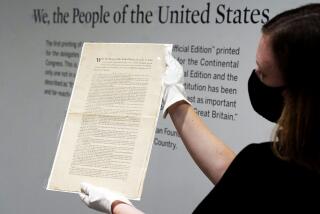Treasured relic from the Bard’s own time
- Share via
ASHLAND, Ore. — In a small theater anteroom, enclosed in a custom-built case and watched over by surveillance video and electronic alarm, lies a relic that connects the Oregon Shakespeare Festival through time almost to the bard himself.
Formally titled “Mr. William Shakespeares Comedies, Histories & Tragedies,” it is popularly known as a First Folio, an original copy of what is considered by many scholars to be the greatest book in English literature, and a touchstone of almost religious significance to those who love Shakespeare.
It’s here for the summer, on loan from Microsoft billionaire Paul Allen, who has been attending plays at the festival since he was a teenager.
“When I first saw it, I had this sense of remarkable power that’s come into this document,” said Paul Nicholson, the festival’s executive director. “It’s 380 years old. It’s in extraordinary condition. And it’s the bedrock of everything we do.
“Without this document, this organization would not exist. The town of Ashland would not be what it is. And there are millions of people in this world that would be much poorer [culturally] than they are today.”
Published in 1623 by fellow actors seven years after Shakespeare’s death, it marks the first appearance in print of 18 of his plays, plus 18 others that had already been printed individually, and includes an engraving of the portrait by which the world has come to know him.
The word “folio” refers to the way the book was printed on both sides of a sheet that was folded once down the middle, creating four pages.
Scholars figure that about 750 were printed but only about 240 survive, said Georgianna Ziegler, head of reference for the Folger Shakespeare Library in Washington, D.C., which holds 82 of them. Most are in museums, universities or libraries.
In 1623, First Folios sold for 1 pound, equivalent to about $180 in today’s money. The earlier paperback quarto editions of individual plays sold for the equivalent of $5 or $6.
Allen bought his at a Christie’s auction in New York in 2001 for $6.16 million, setting an auction record for works of Shakespeare and 17th century books, according to Christie’s.
Yale University professor Harold Bloom, author of “Shakespeare: The Invention of the Human,” has coined a name for Shakespeare worshippers like himself -- Bardolators -- and likens the First Folio to a sacred text, with a twist.
“As Jesus is both man and god who replaces the book the Hebrew Bible, the First Folio does just the reverse. It replaces a man who is a kind of god in terms of creative power with a book,” he said from his home in New Haven, Conn.
The First Folio on display here was once owned by the grandniece of 17th century English poet and playwright John Dryden.
It contains 908 pages printed in double columns and is bound in brown calfskin dating to the late 17th century or early 18th century.
“There is no copy like this,” said Barry Kraft, a dramaturge for the festival who can regularly be seen clutching his own facsimile copy of a First Folio under his arm.
Each First Folio is different in small ways. The folios were produced by several printers, who sometimes had trouble reading the original manuscripts, which do not survive. They made their own corrections and sometimes changed Shakespeare’s words. Over the years, owners have swapped out pages.
Kraft almost laments that this one is in such good shape, which indicates it was rarely read.
“A book is like a genie in a bottle,” he said. “When you rub the bottle, the genie comes out and transforms your life. Here, whoever owned it through the centuries didn’t get the genie out very much. They were not moved too much by what Shakespeare wrote. They were keeping it as an artifact.”
Festival director Nicholson said he hopes to have Allen’s First Folio back each year.
More to Read
The biggest entertainment stories
Get our big stories about Hollywood, film, television, music, arts, culture and more right in your inbox as soon as they publish.
You may occasionally receive promotional content from the Los Angeles Times.









